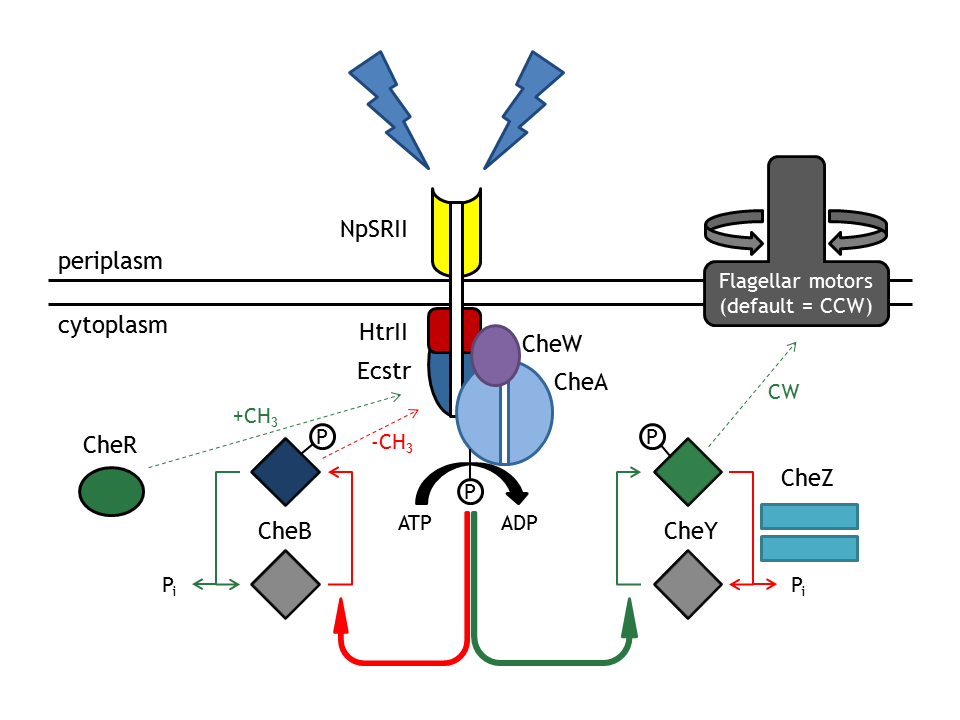Team:ETHZ Basel/Biology/Archeal Light Receptor
From 2010.igem.org
(→Archeal Light Receptor) |
|||
| Line 5: | Line 5: | ||
[[Image:ETHZ_Basel_archean_chemotactical_network.png|thumb|400px|'''Schematical overview of the chimeric chemotaxis pathway. '''ALR refers to the archeal light receptor, MCPs to the membrane receptor proteins and Che to the intracellular chemotaxis proteins.]] | [[Image:ETHZ_Basel_archean_chemotactical_network.png|thumb|400px|'''Schematical overview of the chimeric chemotaxis pathway. '''ALR refers to the archeal light receptor, MCPs to the membrane receptor proteins and Che to the intracellular chemotaxis proteins.]] | ||
| - | Besides the light-sensitive Pif3/PhyB-system, another implementation strategy caught our attention: The generation of our E. lemming by the fusion of an '''archeal photoreceptor''' to a bacterial chemotactic transducer. This was successfully demonstrated by Jung ''et al.'' in 2001 [ | + | Besides the light-sensitive Pif3/PhyB-system, another implementation strategy caught our attention: The generation of our E. lemming by the fusion of an '''archeal photoreceptor''' to a bacterial chemotactic transducer. This was successfully demonstrated by Jung ''et al.'' in 2001 [[Team:ETHZ_Basel/Biology/Archeal_Light_Receptor#References|[1]]], who fused the ''Natronobacterium pharaonis'' NpSRII (Np seven-transmembrane retinylidene photoreceptor sensory rhodopsins II) and their cognate transducer HtrII to the cytoplasmic domain of the chemotaxis transducer EcTsr of ''Escherichia coli''. |
| - | + | ||
| - | + | ||
| + | Rhodopsins are photoreactive, membrane-embedded proteins, which are found not only in archaea, but in eubacteria and microbes as well. In ''Natronobacterium pharaonis'', the NpSRII contains a domain of seven membrane-spanning helices, which carry out two distinct functions: Firstly, they serve as photo-inducible ion-pumps and secondly, as actors in the chemotaxis signaling network [[Team:ETHZ_Basel/Biology/Archeal_Light_Receptor#References|[1]]]. | ||
=Construct= | =Construct= | ||
Revision as of 19:45, 27 October 2010
Archeal Light Receptor
Besides the light-sensitive Pif3/PhyB-system, another implementation strategy caught our attention: The generation of our E. lemming by the fusion of an archeal photoreceptor to a bacterial chemotactic transducer. This was successfully demonstrated by Jung et al. in 2001 [1], who fused the Natronobacterium pharaonis NpSRII (Np seven-transmembrane retinylidene photoreceptor sensory rhodopsins II) and their cognate transducer HtrII to the cytoplasmic domain of the chemotaxis transducer EcTsr of Escherichia coli.
Rhodopsins are photoreactive, membrane-embedded proteins, which are found not only in archaea, but in eubacteria and microbes as well. In Natronobacterium pharaonis, the NpSRII contains a domain of seven membrane-spanning helices, which carry out two distinct functions: Firstly, they serve as photo-inducible ion-pumps and secondly, as actors in the chemotaxis signaling network [1].
Construct
We purchased the codon optimized version of the archeal photoreceptor NpSRII EcTsr-fusion from Geneart and cloned the sequence as biobrick into the standardized vector pSB1C3 (BBa_K422001).
As membrane proteins are difficult to express at the appropriate concentrations, we decided to subclone the receptor into the IPTG-inducible plasmid pACT3 allowing us to adapt the expression level. The archeal receptor fusion was cloned into pACT3 via BamHI and HindIII. In addition to the BamHI site, the forward primer encodes for a ribosome binding site to ensure the optimal spacing to the start codon.
Forward (5'-3'): GTGGATCCAAGGAGATATACATATGGTTGGTCTGACCACCCTG
Reverse (5'-3'): GCAAGCTTTTAACCGCTATAAATTG
Chemotactic analysis
To observe chemotactic behaviour, cells were grown at 30 °C in Lysogeny Broth to on OD of 1.0. All-trans retinal has to be added to the media for NpSRII to change it's conformation into an active light absorbing pigment. Different levels of IPTG can influence the protein expression level.
Phototactic stimuli were delivered through a light pulse at 500 nm and cells tracked. You can find out more about microscopy and information processing here.
And don't forget, check out our results, the actual E. lemming.
Receptor analysis
Add: SDS Gel of expressed protein, membrane insertion?
 "
"




